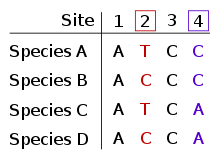Informative site
In phylogenetics, informative site is a term used in the context of maximum parsimony, to refer to a characteristic that can usefully distinguish between samples at a genetic level (for example samples from different species or sub-species). The informative site is a position in the relevant set of sequences at which there are at least two different character states at that point in the sequences, and each of those states occurs in at least two of the sequences. Character states can take on multiple types of data, including morphological (such as the presence of wings, tentacles, etc.) or molecular information such as sequences of DNA or proteins.

Example of parsimony informative sites. In phylogenetics, parsimony informative sites are those with at least two states. Here, this is sites 2 and 4. Site 2 indicates a grouping of Species A and C, while site 4 indicates a grouping of Species A and B. Because these two sites conflict, other analyses (such as maximum likelihood) are needed to resolve the phylogenetic tree of these four species.
This article is issued from Wikipedia. The text is licensed under Creative Commons - Attribution - Sharealike. Additional terms may apply for the media files.